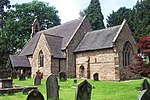Stretton Aqueduct

Stretton Aqueduct is a short cast iron canal aqueduct between Stretton and Brewood, and near to Belvide Reservoir, in south Staffordshire, England. Designed by Thomas Telford and bearing his name plus its date of construction, 1832, it carries the Shropshire Union Canal (formerly the Birmingham and Liverpool Junction Canal) 30 feet (9.1 m) over the A5 road at a skewed angle.The aqueduct has five sections, each 6 feet 6 inches (1.98 m) long, held together by bolts and supported by six cast iron arch ribs, each in two sections and joined at the centre of the arch. It was cast by William Hazledine of Shrewsbury. The trough is 21 feet (6.4 m) wide with an 11 feet (3.4 m) wide channel of water and a towpath on either side. The Staffordshire blue brick abutments have stone dressings.During 1961–62, the road under the aqueduct was lowered by about 4 feet (1.2 m) to allow taller vehicles to pass underneath.It was one of Telford's last aqueducts and has been grade II listed since 1985.
Excerpt from the Wikipedia article Stretton Aqueduct (License: CC BY-SA 3.0, Authors, Images).Stretton Aqueduct
Watling Street, South Staffordshire Brewood and Coven
Geographical coordinates (GPS) Address Nearby Places Show on map
Geographical coordinates (GPS)
| Latitude | Longitude |
|---|---|
| N 52.694267 ° | E -2.189412 ° |
Address
Watling Street
Watling Street
ST19 9QY South Staffordshire, Brewood and Coven
England, United Kingdom
Open on Google Maps









